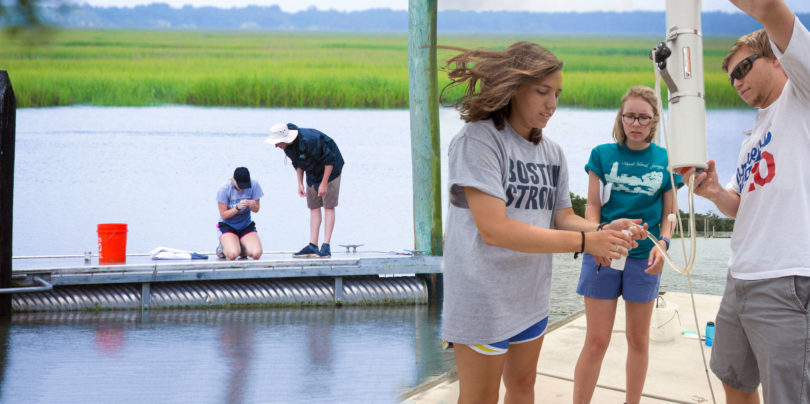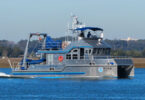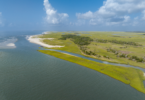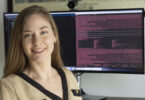By Rebecca McCarthy
It’s a sunny June day on Sapelo Island, and the sound of bugs whirring fills the air. Mary Ann Moran, UGA Distinguished Research Professor of Marine Biology, walks along a dirt road shaded by live oaks and chats with two young men, both UGA students. She scans the trees, searching for a path, and finally pushes through some brush and scrambles down a bank. A narrow boardwalk extends out across the marsh. Two planks wide, it looks like a pair of black shoelaces stretched across an endless expanse of green.
Teacher and students slowly walk a few yards out onto the boards before T.J. Krunkosky jumps into the marsh and Moran follows. It’s low tide, and the black mud swallows their shoes. They jam sticks in among the blades of dry Spartina grass, measure the distance between the sticks using a yardstick, and then square them up. Back on the boardwalk, Malcolm Barnard closes his eyes as he translates inches into centimeters for Moran. She wraps orange DayGlo tape around each stick, setting up test plots.
 During a rainy day at Sapelo, students Taylor Faulk (left) and T.J. Krunkosky observe a marine organism found at a dock. Photo by Dorothy Kozlowski
During a rainy day at Sapelo, students Taylor Faulk (left) and T.J. Krunkosky observe a marine organism found at a dock. Photo by Dorothy Kozlowski
Krunkosky, Barnard and other students are enrolled in UGA’s new coastal summer semester program, spending four weeks exploring the Georgia coast-marshes and beaches as well as the ocean waters out along the continental shelf. Working out of UGA’s Marine Institute at Sapelo Island, off the coast of Darien, and Skidaway Institute of Oceanography, near Savannah, the students are learning about the plants, animals and microbes found in these environments. And they’re picking up some practical advice, as well.
“One of the most valuable things I’ve learned?” Krunkosky says. “How to get out of the mud when it’s up to your thighs.”
More than a year in the making, the coastal summer semester program was developed by the Marine Sciences Department, with teaching duties shared by faculty based at the main campus and at Skidaway. A dozen students are enrolled-11 from UGA plus one from Old Dominion University. Ten of the students are biology and ecology majors. The exceptions are Barnard, who’s simultaneously working toward an undergraduate degree in ecology and a master’s in forestry, and Old Dominion’s Michaela Britt, a geology major.
 Faculty member Mary Ann Moran leads students on an educational nature walk on Sapelo Island. Photo by Dorothy Kozlowski.
Faculty member Mary Ann Moran leads students on an educational nature walk on Sapelo Island. Photo by Dorothy Kozlowski.
All are expected to conduct field research using scientific methods of discovery, according to Moran, who received her Ph.D. from UGA in 1987. “They each design and carry out research,” she says. “They are allowed to go wherever their interests and curiosity take them.”
Whether looking at water quality, soil makeup or fish habitats, each student will come away with a deeper understanding of what constitutes sound research. They also learn that it isn’t done on banker’s hours and that some projects have to be monitored around the clock.
Three or four hours after Moran and her students set up the plots in the marsh, the tide starts coming in. Britt and student Kerra Herrell walk along the boardwalk to the DayGlo tape, one carrying a notebook and the other a yardstick. Britt lies on her stomach as she places the yardstick on the damp mud and measures how far snails in the plot have climbed up the grass, while Herrell records the distance and the time. Another pair of students will return a few hours later to take more measurements. And others will rise in the middle of the night to gather yet more data. Time and tide wait for no student, even those conducting a group research project.
That’s just one part of the investigation. In a nearby laboratory, buckets are filled with marsh mud, vegetation and snails. Here, too, students measure how high the snails climb. In the marsh they climb to stay ahead of the rising tide-and the blue crabs that will eat them. Will they climb as high in the lab, where there’s no tide? The students’ results will help illuminate how the tidal influence in marsh ecosystems is reflected in animal behavior and adaptation.
Naturalist Dale Bishop, an environmental consultant and expert in invertebrate ecology who received his Ph.D. from UGA in 1995, is serving as a visiting instructor for the course.
“Dr. Dale basically knows everything,” says student Dylan Ward. “He knows all the plants, the animals, the ecosystem and everything about Sapelo there is to know.”
Bishop helped Ward design his research project on water quality. After taking water samples from several sites around the island, Ward is evaluating which critical nutrient in the water-nitrogen, phosphorus or carbon-is limiting the growth of the bacterial populations.
Other areas of study include researching dune structure and analyzing soil composition. Britt, the geology student, pounded PVC pipe into a dune eaten away in a recent storm, taking a core sample. The core shows the history of the dune, she says-the color of the sand reveals storm evidence. She estimates the dune is 200 to 300 years old.
Student Jack Owen has joined Britt in the lab at Sapelo and is processing samples of soil cores, preparing them for a drying furnace. He’ll examine the percentage of organic matter in the core and look for a link between plant diversity and distance from water.
“This whole course has been pretty awesome,” he says. “I’ve been going to the beach my whole life, but this is learning how it works.”
A week later, the research vessel Savannah is making its way along the Skidaway River toward the coast, passing countless docks and houses on the water’s edge. The students are starting the Skidaway-based second half of their semester with a research cruise. Associate professor Jim Nelson and Research Coordinator Charles Robertson are showing the students examples of shipboard oceanographic methods. They’re getting exposed to basic instrumentation and sampling as well as to life aboard a ship large enough to feed and accommodate 16 people, plus a crew, for weeks at a time.
The gentle rocking has affected a few students, who’ve moved away from the lab’s sophisticated instruments-including an acoustic Doppler system that profiles ocean currents-and onto the back deck. There, they prepare for sample collection and watch dolphins racing in the wake and flying fish skimming the waves.
 In the SkIO lab, Sarah Gardner (right) prepares a seawater sample for analysis while Maggie Shiffert (left) and Haley Haynes observe. Photo by Peter Frey.
In the SkIO lab, Sarah Gardner (right) prepares a seawater sample for analysis while Maggie Shiffert (left) and Haley Haynes observe. Photo by Peter Frey.
The pitching of a ship is familiar to student Sarah Gardner, who has been scuba diving with her father since she was 15. She prefers being out on the water to being in a lab. “I like the microscope, but I don’t want to look at it 24/7,” she says.
When the ship stops, the professors and student Taylor Faulk take sediment samples off the back deck, dropping a coring device, a weighted canister, down to the ocean floor. Later, back at Skidaway, the students will analyze the samples in a lab-part of a former 700-acre Angus cattle farm gifted to the state, which has converted the original buildings and constructed new ones.
There’s more sampling to do when the ship stops again. A winch controlled by a crew member lifts a CTD (conductivity, temperature and depth) profiler, a large carousel carrying 10 8-liter sampling bottles, from a side deck. With students Haley Haynes and Sarah Gardner, Robertson guides the cluster of bottles over the water and the crane lowers it. Throughout the day, the carousel goes in and out of the ocean, retrieving samples from a little more than 3 feet below the surface and near the bottom, about 40 to 60 feet deep on the inner shelf waters sampled during the cruise.
In the lab on board the Savannah, Robertson supervises students as they take and label samples from each bottle, add various chemicals, take measurements and then store them in liquid nitrogen. On shore the next day, Robertson will walk students through the steps of the Winkler Method, which measures dissolved oxygen in the water, an indicator of the health of an ecosystem. Devised by Ludwig Winkler, the test dates back to 1888.
“We could be aboard a wooden ship,” Robertson says, laughing, “and I could be doing this test wearing an eye patch and a wooden leg.”
During the first week of the coastal summer semester program, the students were on Nanny Goat Beach learning about invertebrates when they ran into Arden Anderson, a Georgia Department of Natural Resources employee. Arden monitors turtle nesting sites and had found a loggerhead turtle that was stuck on a sand bar. The students helped her free the animal and point it toward the ocean.
“Dr. Dale has seen most everything on Sapelo, but he’s never seen a sea turtle,” says Lizzie Wesley, a student who’s part of a group research team focusing on fiddler crab dispersal. “But we got to see one! We even got to help rescue one, and it was so cool!”
Such hands-on experiences in the field, plus lectures and lab work, integrate to create a powerful learning experience. The program also aligns with the university’s recent initiative to require experiential learning for all students.
“If anyone has the opportunity to take this class, they should do it, because it gives you the chance to do so much more than just sit in a classroom,” Haynes says.
Ecology student Maggie Shiffert lauded the combined fieldwork and research focus-especially the experience of walking in a marine scientist’s sometimes mud-covered shoes.
Faulk, a Savannah native, says the research cruise was his favorite part.
“My family’s house is there on the marsh, and I’m out there all the time,” he says. “But it’s so cool to learn the science behind all of this. I want to be a doctor, and I think this is going to help me when I do research.”
– This article originally appeared in the September 2015 issue of Georgia Magazine.






